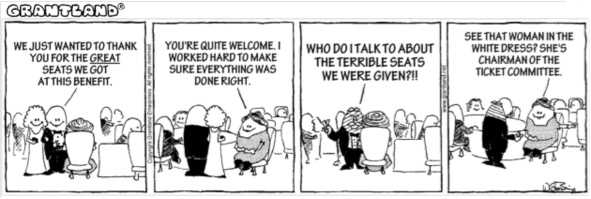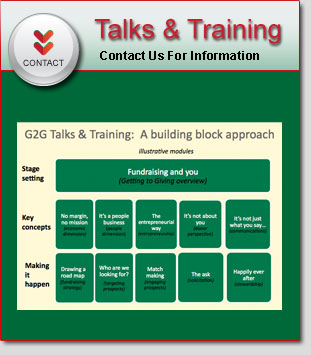One of my least favorite images is that of the fundraiser as the Lone Ranger, swooping in on his horse to heroically seize the day. But, hey, what about Tonto?
Fundraising is not just the person who makes the ask, whoever that may be. It requires a team of people with special talents. What brings it all together is a common purpose. Then you need to understand everything that needs to be done, leverage each person’s strengths to do it, and make sure each person feels recognized and appreciated for his contributions.

Copyright, Grantland Cartoons (www.grantland.net)
As a fundraiser, you should know where you need help, feel free to ask for it, and be able to get it. With three prospect meetings a day during the Harvard Business School campaign, I knew that I needed help keeping everything straight: What happened at our last meeting? What was the name of the prospect’s husband? I relied on briefings prepared by staff, that I read the night before or in the cab. I knew that I could count on travel arrangements that would get me where I needed to be, when I needed to be there, and not annoy a prospect by being late. (On the other hand, I do like to personalize all my thank you notes.)
Unfortunately, too many fundraising organizations are competitive, political cauldrons. One development officer had an outstanding reputation for developing strategies for his prospects. Unfortunately, he never seemed to get around to executing them. “Ready, aim…ready, aim…ready, aim…” was how one person described it. Eventually, I asked him: “Can I reassign this donor? You haven’t called on him.” The reaction: screams of “That’s my prospect, he’s on my list!” That sort of competitive attitude can be reinforced by performance metrics, evaluation and compensation systems, and culture. But, it can be corrected similarly.
Organizational structure also can contribute to competition. I’m often amazed at how siloed fundraising organizations tend to be. Within individual giving, there may be major gifts, annual giving, planned giving, a capital campaign, and more. Each group may be fighting for “donor rights.” Donors, however, may not care how their gift is categorized. What may annoy them, however, is making a donation, and then being “nickel and dimed” for special events or contributions to other groups. Fortunately, there are ways to address structural issues too, with cross functional teams or donor-centered liaisons, for example.
The “fundraising organization,” however, is not just the folks in the development office. It is – or should be – a partnership among staff, volunteers, and donors. Roles will overlap: board members should be expected to make donations; many donors play essential volunteer roles; both staff and volunteers provide expertise and hands-on support. Roles do need to be clearly defined, in any given situation, to prevent confusion. But, the most important thing is to recognize that it is a true partnership, requiring a spirit of collaboration and shared commitment.
What is the role of fundraising leadership, in all this? Fundraising team members often cite leadership as critical to campaign success, as well as their personal commitment to, and satisfaction and pride in participating in it. They speak of leadership rapport with prospects, donors and other external partners. Internally, they see them as role models for mutual respect, teamwork, trust, entrepreneurism…and a sense of humor. Leadership can create an environment where everyone, not just the formal fundraisers, feels responsible for success. One example: 100% of Mount Auburn Hospital doctors and 60% of nurses showed their commitment to the organization’s mission by making personal donations to a major campaign.



